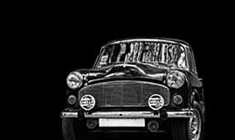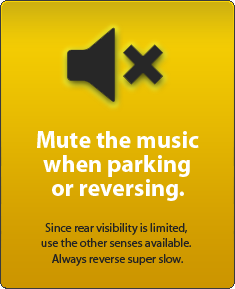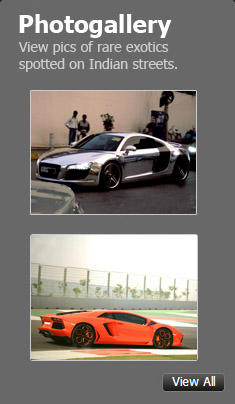News
25 modifications made over 5 years on my Creta: Ownership experience
The fuel efficiency of the SUV ranges anywhere from 13 km/l to 20+ km/l, while the odometer has crossed the 50,000 km mark.
BHPian Chhanda Das recently shared this with other enthusiasts.
We recently celebrated the 5th birthday of our automatic petrol 1.6 pre-facelifted Creta also known as Blaze. The following is a detailed user experience of the car right from the planning stage through buying, servicing and modifying it for car camping while encountering various ups and downs in between. So please fasten your seatbelts for the long trip ahead.
Why did I buy my Creta?
I do not know about others but here is what I did. Before that, here is a little background information. I have been around cars for most of my life as far back as I can remember starting with my Grandfather's Landmaster more than half a century ago in a nondescript place in upper Assam. My previous car was a 1986 petrol Mark 4 HM Ambassador which I used for almost 2 decades primarily all over North East India before selling it off (primarily due to the non-availability of parts) in 2005. We had quite a few memorable experiences with it and you too can read about them in this link.
I relocated to Kolkata later where Ambassador parts are still easily available (since they are still used as Taxicabs here). I could have kept my car but decided against it as it made me emotional every time I looked at it since it brought back unpleasant memories about the untimely and tragic demise of my dear husband in an M&M vehicle.
Anyway, once I moved to Kolkata, I didn't feel the need for a car since Kolkata apparently has the best public transport system in India as per the Government of India. However, the urge for the freedom of owning a car was always there but the emotional baggage prevented me from owning one. And I was often looking at cars but would get dejected by something or the other like low bonnet height, poor design, non-availability of parts, expensive parts/repairs, lack of properly-knowledgeable people, etc. And like most people, the internet was not very accessible (read cost-prohibitive) for me. I was mighty impressed by the Ford Endeavour, Mitsubishi Pajero and Toyota Fortuner since I first saw them in magazines.
Life went on and fast forward to 2016 when some favourable circumstances meant that I could almost afford nearly any car that a middle-class person could realistically buy and maintain. Thus began the search for a car either preowned with only one owner (more preferable) or completely new. I started going through the reviews and issues of the various cars along with the mandatory Youtube videos and the individual car owners' groups on Facebook. I had no idea up to this point that there is something called "Team Bhp" helping car owners (past, present and future) in numerous ways. I wanted to become a member but my application was rejected twice (I have no idea why). Thankfully, we can access the contents of the website even if we are not a member. I started going through the reviews and issues of the various cars along with the mandatory Youtube videos and the individual car owners' groups on Facebook.
But which car to choose?
Cars below 4 metres in length were out of consideration since I am from a generation spoiled by the roomy HM cars. Moreover, car camping in smaller cars is difficult. I started to approach the problem through a process of elimination. Tata was out of consideration because we had faced more than our fair share of issues with the Tata vehicles in our family including both cars and trucks. We didn't even think of adding Mahindra & Mahindra cars to the list because we had lost family members in them. The sizes of the Endeavour, Pajero and Fortuner meant that I couldn't use them regularly in congested city traffic and small parking spots even though they would satisfy my other requirements for car camping and highway travel. Moreover, I am averse to diesel (mainly due to their clatter) and these cars' petrol engines returned eye-watering single-digit fuel economy figures in the city. I did not even consider the Germans because I am not willing to pay exorbitant prices for the entire period of ownership with little or no chances of repairability otherwise. I did not consider 4x4s/4WDs/AWDs because I never felt the need for them despite driving on some of the most treacherous terrains of North-East India.
Back to the drawing board then. There is no guarantee about the type of roads in India. So sedans and hatchbacks were automatically out of consideration due to their low ground clearance. Obviously, we would have to compromise on handling but it is not as if we are competing in an F1 race on our mostly pathetic highways. This time I decided to approach it from the bottom of the rung. And did I mention that I wanted an automatic? I did not want my son to face mobility issues due to incessant clutch use in the city. Anyway, the first car that I looked at properly in a long time was the Renault Duster (gorgeous looks ?) but it didn't have an automatic petrol option. Still, I thought that we could live with it. However, I was highly disappointed when it scored "0" stars in the NCAP tests. I was also looking at the Honda B-RV and the Hyundai Creta (1st generation) in the meantime. I liked the B-RV but I didn't like the fact that its automatic version came with a CVT. Moreover, the availability of parts and repairability may become an issue later since it wasn't getting sold much. And I absolutely hated the Creta's looks even though it ticked all the right boxes like a naturally aspirated petrol engine, larger than 4 metres, torque converter, etc. In the meantime, Jeep launched the Compass and I liked it a lot. But there was no guarantee of the availability of parts in aftermarket shops and service centres were almost non-existent. Moreover, my Grandfather always used to say "Never buy a car unless it has existed in the market in a relatively trouble-free fashion for around 3 years" he was the smartest automobile enthusiast that I knew in spite of the fact that he was a medical doctor.
To cut a long story short, we had almost decided upon the Duster since it seemed value for money and were days away from booking it when the bombshell of "0" stars NCAP rating dropped like a bolt out of the blue. This is when the Creta started looking more and more attractive with its stupid grinning face. Due to its huge chart-busting sales figures, we were sure about its availability of parts. But we were still not sure whether it would be easy to fix. This is when I accidentally stumbled across its service manual on a social media platform. After going through it for a few weeks, we realized that it was very easy to fix and technically very stable, unlike the HMs, TATAs and M&Ms that we had used all our lives. The Creta had already proved its build quality by scoring 5 stars in C-NCAP tests. Also, its bonnet height matches the ladder frame chassis of trucks and that is a big advantage on our highways in case of an unfortunate accident.
But we faced a big dilemma. We were seeing quite a few people complain about Creta's brakes on various social media platforms including Team Bhp and frankly speaking, we were naturally apprehensive. However, there was still the fact that the Creta was getting sold like hotcakes despite such complaints. Logic says that if a car has issues in something as critical as brakes then it wouldn't get sold as much as the Creta was getting sold despite the presence of other options. Hence, we decided to ignore such complaints and move on. Moreover, my son is not an aggressive driver.
Then came the question of Creta's unattractive looks. My son coaxed me by explaining that looks are for others to enjoy when I would be spending most of my time in the front passenger's seat of the car. I also told myself that I am not buying the car for myself since I cannot drive anymore due to eyesight issues. So what I should do is guide him to make the best decision and not make the decision for him.
However, this was also a time of financial turmoil since GST had been launched in India. The taxes on cars above 4 metres were reduced which kind of forced our hand or else we would have waited and researched some more. We also received the news at this time of the upcoming facelift that was supposed to have a sunroof which we wanted to avoid. Anyway, we bought our brand new Creta 1.6 petrol with a torque converter automatic transmission in 2017 after researching for around one and a half years mainly on social media but without a single test drive. Sadly, we couldn't find used ones or else we could have bought them for much cheaper. But there is also the fact that new cars can be much cheaper to maintain in the long term than used ones. Our car has run for approximately 52k kms to date and touchwood, we have never faced any significant issues with it. The car's looks have grown on me since we bought it (Stockholm syndrome?) and we absolutely adore it now. I named it Blaze after drawing inspiration from a horse named Silver Blaze from one of Sherlock Holmes' stories.
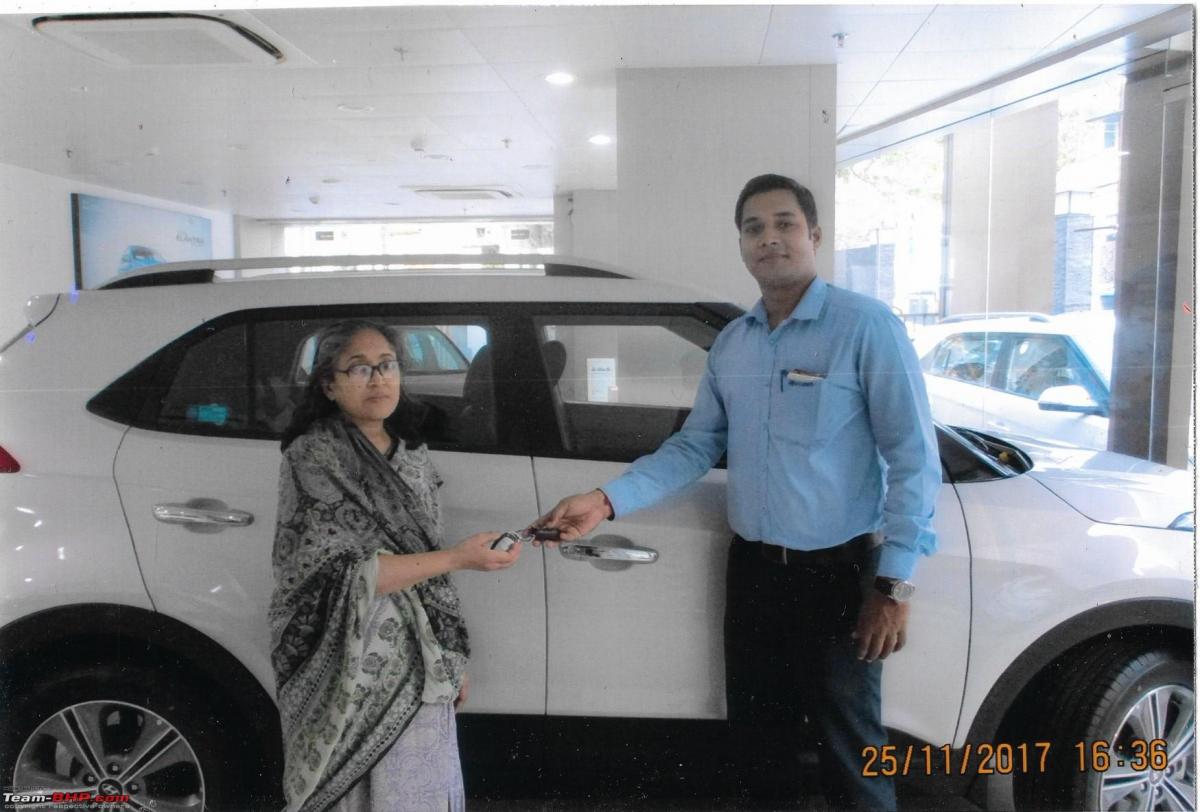
We chose this car after meticulous research spanning one and a half years with my primary focus being safety, comfort, ease of maintenance, proven reliability, availability of parts, cost of service, market reputation, etc. My grandfather's words played a huge part in the decision-making even though he passed away a few decades ago. He was the one who taught me to drive in his Landmaster almost 5 decades ago. Sadly, I had to give up my driving license about a decade ago due to failing eyesight and my son is the only driver of my Creta now. Some of my grandfather's gems were the weight of the bonnet is a good indicator of build quality, the position of the bonnet of your car should not be lower than the ladder frame chassis of a truck, etc. Touchwood, I have never had to regret my decision.
Service Experience
Service experience at Hyundai ASCs has been rather bland but seamless. However, we were pleasantly surprised to be acquainted with very knowledgeable and competent service technicians at the second ASC compared to the pathetic ones at the first ASC which we had visited near my home here in Kolkata. These capable service technicians also have their own Youtube channels where they regularly post video guides about how to fix various issues in Hyundai cars for the benefit of both customers and aftermarket repair shops.
The car has covered almost 52,000 km. The car is based in Kolkata but has been to many other places in West Bengal, Jharkhand, Bihar, Assam and Meghalaya. Fuel efficiency on the highway ranges from 13 km/l (with full load) to 20+ km/l (with minimum load).
Here are the service costs that I have incurred on Blaze as follows:
- 1st service at 1.2k kms at Hyundai ASC for INR 0. Labour charge INR 0.
- 2nd service at 10k kms at Hyundai ASC for INR 1071. Labour charge INR 0. (image below)
- 3rd service at 20k kms at Hyundai ASC for INR 1260. Labour charge INR 0. (image below)
- 4th service at 30k kms at home for INR 1803 plus approximately INR 70 for optional consumables. Labour charge INR 0.
- 5th service at 40k kms at home for INR 1206 plus approximately INR 70 for optional consumables. Labour charge INR 0.
- 6th service at 50k kms at home for INR 1220 plus approximately INR 110 for optional consumables. Labour charge INR 0.
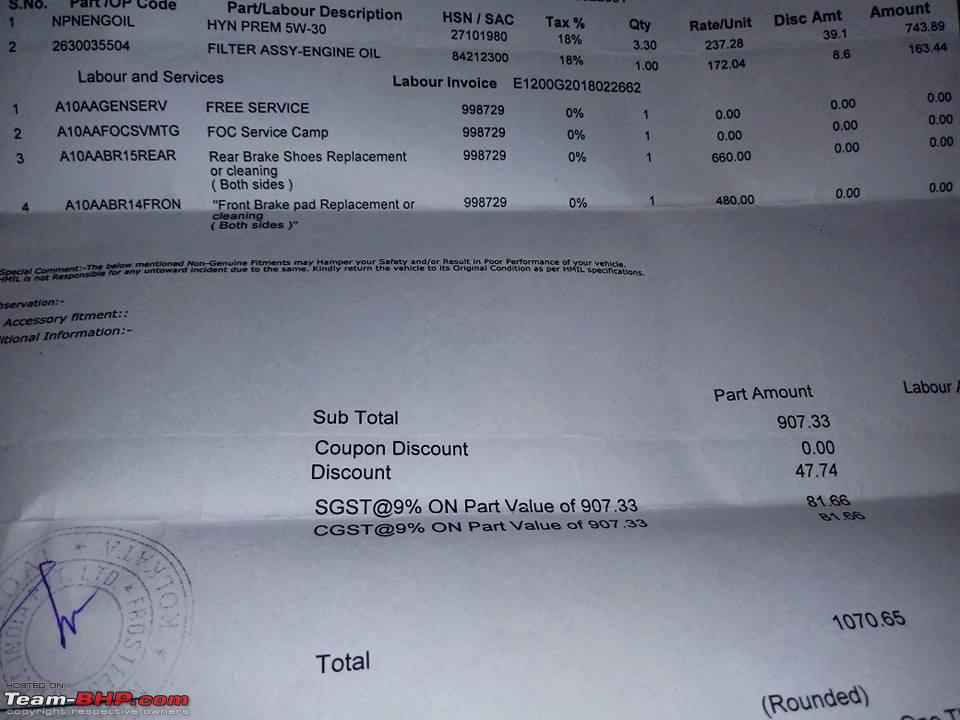


The 4th and 5th services were performed by my son under my supervision but I didn't have to supervise him for the 6th service. Wheel alignment was done 3 times for a total of INR 800. Here are some images taken by my son while servicing various aspects of the car:

The worst abuse that Blaze had to face was when it had to cover the treacherous terrain of Meghalaya in a totally overloaded condition. The overloading was to the extent that it had absolutely zero suspension but we did not face any issues at all and the car covered the terrain beautifully.
Positives about the Hyundai Creta:
- very low NVH (Noise, Vibration and Harshness) levels
- linear acceleration with 0-100 km/h in around 10.5 seconds due to the naturally aspirated 1.6-litre BSIV engine
- very comfortable seats. Back-to-back 17-18 hour drives are not a problem at all
- the rear seats fold down to a full-size flatbed for 2 adults
- very ergonomic placement of things
- good ground clearance
- ease of tweaking, modifying and adding features
- creep function is a boon in the city
Negatives about the Hyundai Creta:
- does not show live fuel consumption rates but we added that feature using a Bluetooth-based OBD2 adapter. (video below)
- does not have load-bearing roof rails even though that can be fixed with suitable aftermarket replacements
- does not have driver's side grab handles on the roof in the front.
- the wheel rim for the spare tyre is made of steel while the other four are made of alloys.
- the rear middle seat belt is of the two-point type and not the three-point type like the other ones.
- the power window buttons apart from the one for the driver's window are not illuminated but this feature can be easily added with some suitable genuine Hyundai spares.
- the central armrest for the front occupants does not slide forward like that in the facelifted first-generation Creta but that can be easily added with some suitable genuine Hyundai spares.
- the door armrests are made of hard plastics but that can be replaced with the genuine Hyundai door panels of the top SX(O) variant which have softer faux leather pads.
Some of our experiences with our Creta have not exactly been hunky-dory. Here are some not-so-good experiences involving our car:
- During the 2nd service in 2018, one of the service personnel at the Hyundai ASC forgot to tighten one of the battery cells covers in our car after filling the distilled water. Thankfully, my son was right there and noticed this. The service person tightened it later after being reminded by my son.
- During a trip to Murshidabad in West Bengal, we had a small accident for no fault of ours. We were going at a leisurely 35-40 km/h when a speeding truck on the oncoming lane hit a slightly protruding metal barricade which almost flew straight at us. My son braked hard and it barely scraped the front bumper right below the fog lamp on the driver's side. However, we felt a bump and heard a tinkling of broken glass behind us. A Toto rickshaw had been tailgating us and had hit the brake lights of our car on the driver's side after losing control. Sadly, we didn't have a dashcam then but thankfully, insurance covered everything apart from the claim filing charges.
- During the 3rd service in 2019, one of the service personnel at the Hyundai ASC dropped one of the spark plugs on the floor while cleaning it. They were about to replace just that one when my son insisted on replacing all four for free. It took some convincing but my son has a gift of the gab and they eventually acceded.
- I was very frustrated while trying to pay the 5-year road tax online for my car recently. It is a very convoluted process full of glitches and frankly, a royal pain in the behind. It took me and my son nearly two days' worth of repeated attempts but we eventually paid the tax successfully. In stark contrast, it took us less than 4 minutes to buy car insurance online.
- In 2019 while on a trip to North Bengal, we almost had an accident when our car slipped/skidded on some differential oil and mud. Thankfully, no harm was done. Here is the dashcam footage.
- A drunk tractor driver hit the driver's door of our car which was parked quite a few feet away from the road near Bankura district in rural West Bengal with the protruding axle of his trailer. The locals caught him and wanted to hand him over to the cops for drunk driving. However, he started sobbing and narrating his family issues which was apparently the reason for his drinking. In our experience, a drunk person is usually very truthful. Taking pity on his sorry state, we let him go but on the condition that he would never drink and drive again only after he had called one of his acquaintances to drive his tractor + trailer back home. Thankfully, we were able to fix the dent/incision ourselves for a cheap rate later at home.
- Recently we had to remove the battery from our car. Due to the incessant fireworks on Diwali night, our house cat got scared, went into the engine bay of our car and hid there. Later we discovered that she had delivered substantial amounts of excreta over the engine and urinated all over the battery including its side. My son cleaned all of that by himself. When the area seemed relatively clean, he removed the battery for the first time since we bought our Creta in 2017. Apparently, there was still some cat urine left under the battery. We could have left it there but since cat urine is acidic, it would have corroded the metal parts. So he had to clean that too. Moreover, the putrid smell would have permeated into the cabin since the AC air intake is located near that location. As you can see below, the stock battery is more than 5 years old and still going strong, touchwood. The warranty on this battery expired in 2019.
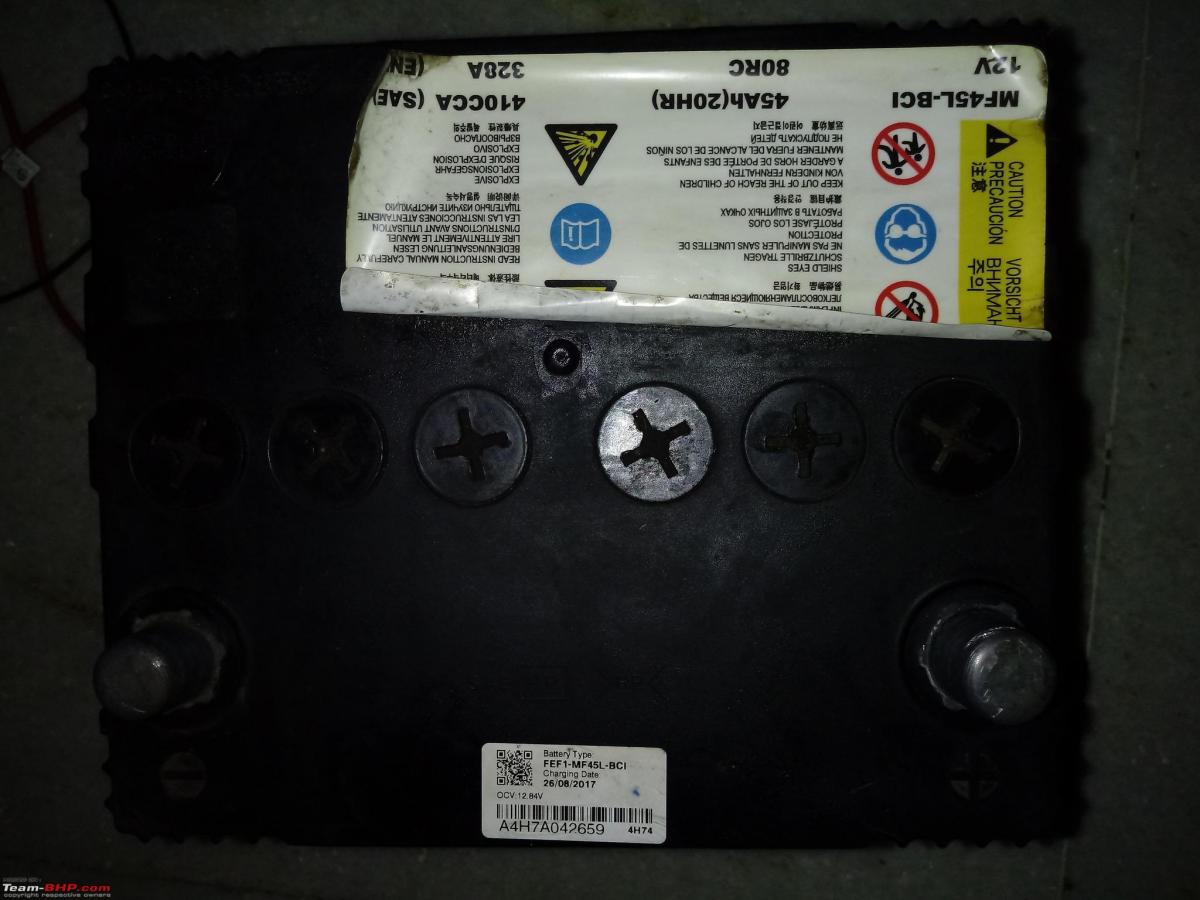
We have also had some very good experiences involving our Creta as you can see below:
- We have always had good experiences with Police personnel on the road irrespective of the State
- The following happened while car camping in Garh Jungle in West Bengal and it is by far the best experience that we have had with Blaze
We have added a few gadgets and done a few modifications for our comfort and safety during car camping and touring as described and shown in the images below. Please note that all prices are in Indian Rupees or INR and inclusive of all charges like taxes, delivery, etc.
1. Attached to the left side of the driver's seat is a 180-watt 12v DC to 220v AC sine wave power inverter from Aliexpress for approximately INR 800. On the right bottom corner of the steering wheel inside the fuse box is the Bluetooth OBD2 device from Amazon India for approximately INR 450. On the dashboard beside the mobile phone mount (approximately INR 600 from Amazon India) is the Solar Tyre Pressure Monitoring System from Aliexpress for approximately INR 1200. Above the mobile phone mount is the SjCam SJ4000 action camera from Aliexpress for approximately INR 3200 which we use as a dashcam.

2. In front of the gear lever in the upper row is a 120-watt 3-socket cigarette lighter socket power splitter (approximately INR 400 from Aliexpress) with one socket occupied by the plug and switch for the footwell lights or floor ambient lights. This 120-watt splitter powers on and off with the accessory mode of the engine start/stop button. The lower row of the two 12-volt sockets along with the voltmeter and the 2 USB 5-volt ports is hardwired to the battery through the 20 amperes rated switch shown below and costs us approximately INR 300 from Aliexpress.

3. Puddle Lamps for each door running on 3 AAA 1.2v NiMH rechargeable batteries for INR 564 from Aliexpress. More details here
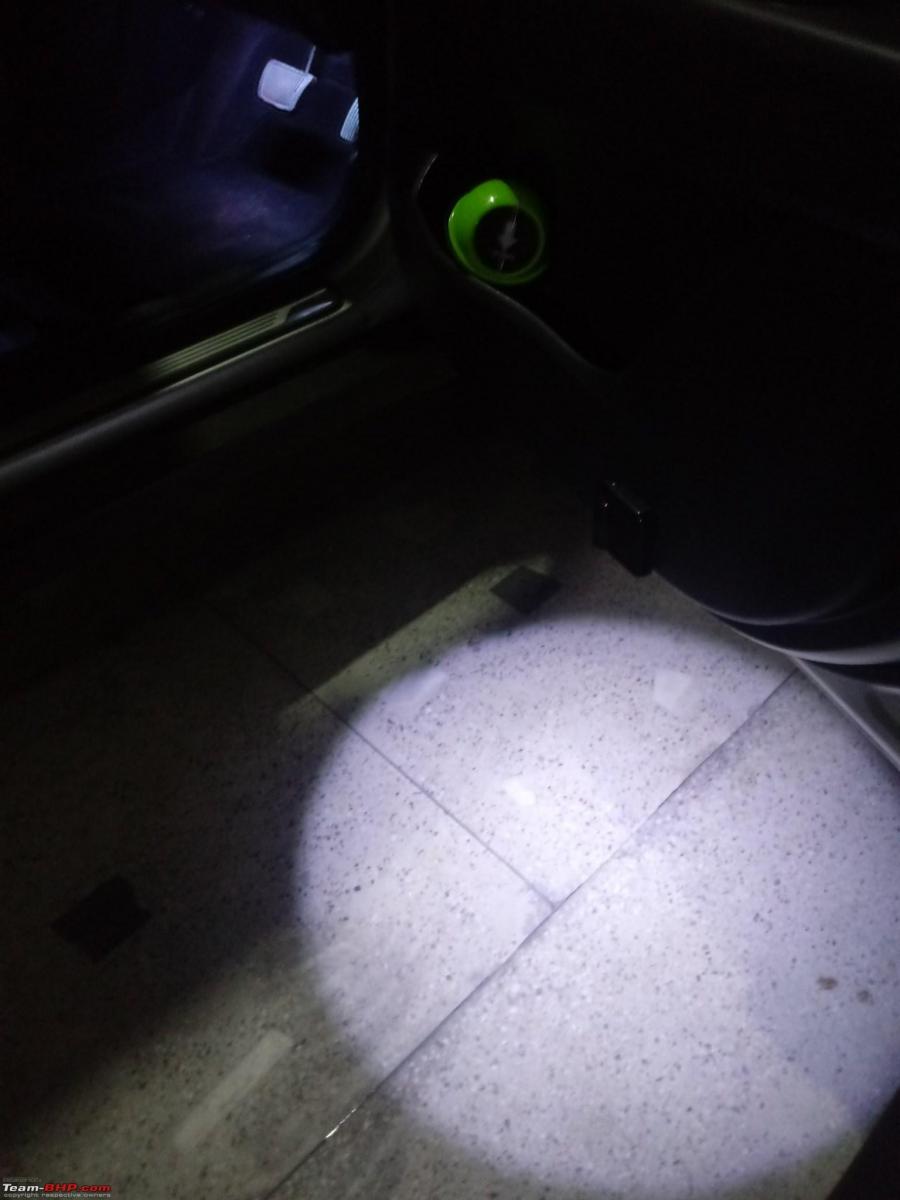
4. An IndelB branded compressor based 50-litre 45-watt car freezer refrigerator (-18 to +12 degrees centigrade) which is rated to run on both 12-24 volts DC and 220 volts AC power. It can actually run within a voltage range of 10.5-28 volts and has 3 different user-settable low-voltage automatic cutoffs. The compressor is made by Secop (formerly known as Danfoss) who were the pioneers in mobile direct current compressors for RV refrigeration and air conditioning. While car camping during the summer, we use 1-1.5 litre ice bottles wrapped in towels as cuddle toys while sleeping in the car. The ice does not melt completely for approximately around 8 hours which is more than enough for a good night's sleep in the car. We use the ice bottles from this freezer together with some portable fans and those are more than adequate for sleeping in the car. We use this fridge both at home and in the car. The 220v AC to 12v DC power adapter originally provided with this fridge died last year after a lightning strike during a thunderstorm due to an electrical fault in our building. We have replaced that adapter with a cheaper one having the exact same specifications as the original from Amazon India and the fridge is working absolutely fine. We mount this fridge to the back of the rear middle seat after folding it down and then use ratchet straps to hold the fridge in place. This still leaves space for two adults to sleep on either side of the fridge. This cost us approximately INR 46k from Tropicool India and it is by far the most expensive addition to our car.

5. Replaced the 3 cabin lamps with white LED ones. The new LEDs are of the unbranded C5W model and have a length of 31 mm with festoon connectors. The pack of 10 lamps from Aliexpress cost us approximately INR 60.

6. 60-watt car dual pump pressure washer which can run on both 12v DC and 220v AC power. It can run directly on 12v DC but needs a 220v to 12v DC adapter when running with home power. The pressure is more than adequate to remove bird droppings from the clear coat on the car's paint and dried mud from the wheel area of the car. The pressure can be controlled for usage as a regular shower as well as a health faucet which is a luxurious boon when camping in the wild. It has an auto-cut feature too which shuts off the pumps when the handle is released and this is great for energy conservation. The pumps start again automatically when the handle is pressed. We got this for approximately INR 1800 from Amazon India.

7. A box of tissues mounted on the front passenger's side sun visor and a clothesline installed on the rear roof-mounted grab handles for approximately INR 90 and INR 40 respectively, both from Aliexpress. The clothesline also serves to hang a privacy curtain when my son is working at the front on video calls on his laptop computer. You can also see the small cushion attached to the front passenger's seatbelt which is very useful for preventing small cuts and bruises on the base of the neck, especially on longer trips on bad roads for short people like myself.
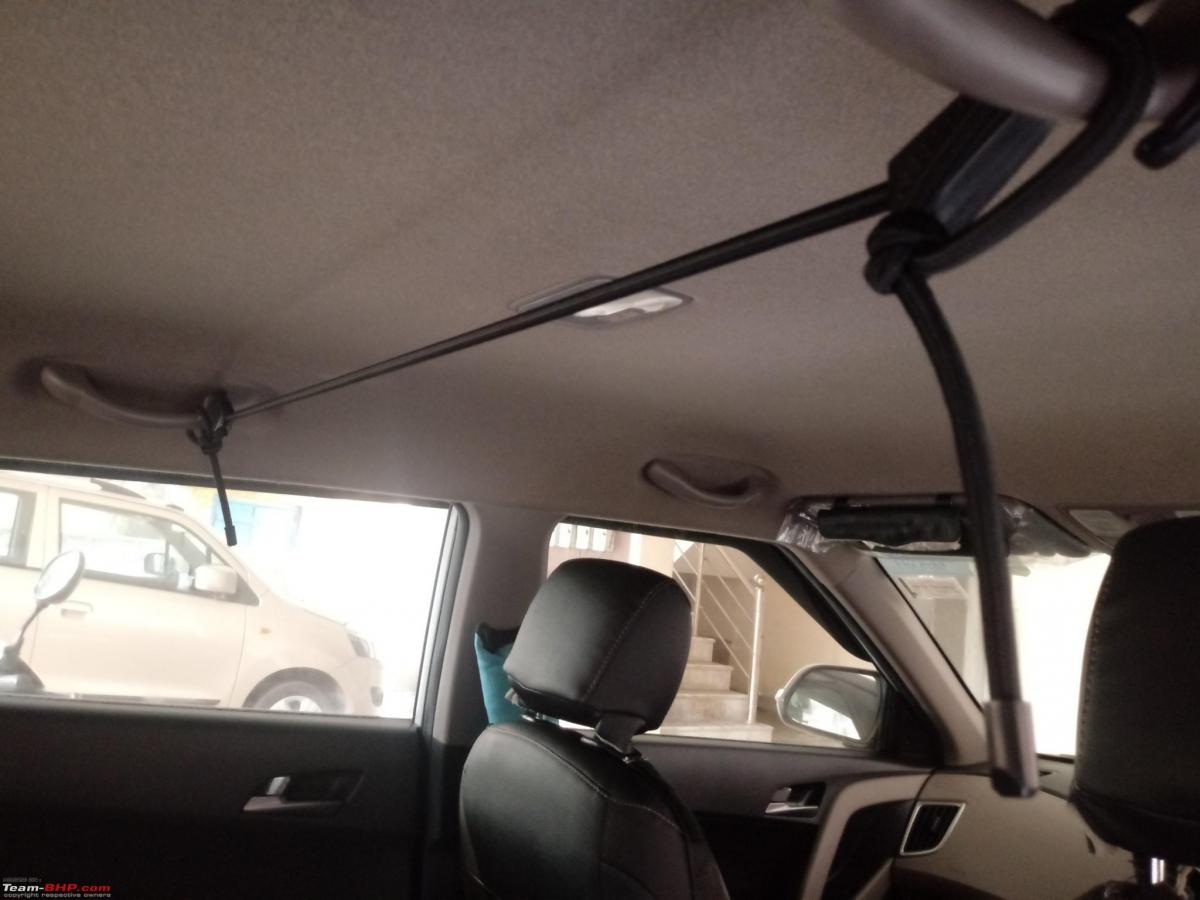
8. An electric massager with heating functionality consuming 27 watts at 12 volts DC is very useful for my old bones. I use it at home too with the 220v AC to 12v DC adapter that came with it. I got it from Amazon India for approximately INR 600.

9. This is a type of partial seat cover that acts like 12v ventilated seats. This is powered by a removable 120mm 12v 1 ampere desktop computer case fan housed inside a centrifugal assembly that draws the cool (or hot) conditioned air from near the legs and pumps it to our back and behind. It has two fan speed settings and the fabric is washable by hand. It is an absolute boon in the scorching Indian summers. I got two of these for approximately INR 1600 from Aliexpress. The air pressure is slightly more than that of the stock ventilated seats of the top variants of the facelifted 1st generation Creta.

10. A cushion pad so that my old right knee does not get banged against the hard plastic on bad roads. Sadly, I could not attach a similar cushion pad on the left side because that is exactly where the door audio speaker is located. This cost me approximately INR 120 for a set of 6 from Aliexpress.

11. We got a Xiaomi 20000 mAh power bank (actual capacity after accounting for conversion losses is around 14000 mAh) to power both 3-speed (3.6 watts each) fans for at least 8 hours or more while the engine is off. High capacity micro-USB male to USB male cable for charging the power bank through Xiaomi's Qualcomm Quickcharge 3.0 compatible 18-watt fast car charger to recharge the power bank as fast as possible. All the items from Xiaomi India cost us a total of approximately INR 1900 while the USB fans above cost us approximately INR 150 each from Aliexpress. This was our only cooling fan setup till we upgraded to the DIY 12v cooling fans shown.

12. Added a few storage spaces to store various items like the power inverter, power bank, USB cables, USB lights, bottle for the wiper fluid, etc all for a total of approximately INR 240 from Aliexpress.

13. Added a 50-watt monocrystalline solar panel with a 10 ampere-rated PWM charge controller for lead acid batteries to recharge the car's battery while the engine is off. We have upgraded the charge controller to a 30 ampere-rated one with support for lithium ion, lithium iron phosphate and lead acid batteries since then for approximately INR 950 from Amazon India.
14. Added a DIY car cabin chimney/exhaust/ventilation system
15. Added a 3-litre drinking water bladder and mounted it on the back of the driver's seat for my son. I chose to get this for a wide variety of reasons. Unless he sits very low, it is nearly impossible to drink approximately more than half of the water in a bottle because the lower end of the bottle would keep getting obstructed by the roof of the car. He can only stretch his neck to an extent and adjusting the driver's seat while driving is absolutely not an option. On bumpy roads, a bottle can damage the teeth, gums and lips. I do know quite a few people who have faced this, especially on bad roads in Eastern and North-Eastern India. A bottle can slip from the hands (especially on bad roads) and land in the driver's footwell area causing an accident by getting stuck under the brake pedal which is not exactly rare according to survivor accounts. There is always a chance of water spillage causing a mess to our clothes as well as to the car's electrical/electronic systems not to mention the increased chances of rust/corrosion issues. Transparent water bottles have been known to start fires in the car's cabin by acting like a magnifying lens for the sun's rays. On trips, we often do not stop our car due to various reasons like security concerns, shortage of time, fuel efficiency concerns, slow-moving highway traffic, etc. But staying hydrated while driving is very important. As some of you may know, sipping small sips of water regularly instead of drinking in one go from a bottle allows the body to stay hydrated without having to answer nature's calls frequently and this technique is often used by endurance athletes, special forces, mountaineers, rock climbers, hikers, etc. Hence, the choice of a water bladder seemed obvious. Moreover, it is way easier to drink from the attached pipe in a state of sleep-induced near-stupor at night without causing any water spillage, unlike a bottle. This cost us approximately INR 600 from Aliexpress.

16. Added a UN-approved 20-litre or 5-gallon steel jerry can for carrying gasoline/petrol

17. Added a portable 78-watt DIY (RO+UV+UF) based water purification system with a TDS controller
18. Added a toolbox made by Taparia (Model number: PTB-16) for approximately INR 500 from a local shop. This fits perfectly in the space between the boot lid/door and the refrigerator without eating into the legroom while sleeping.
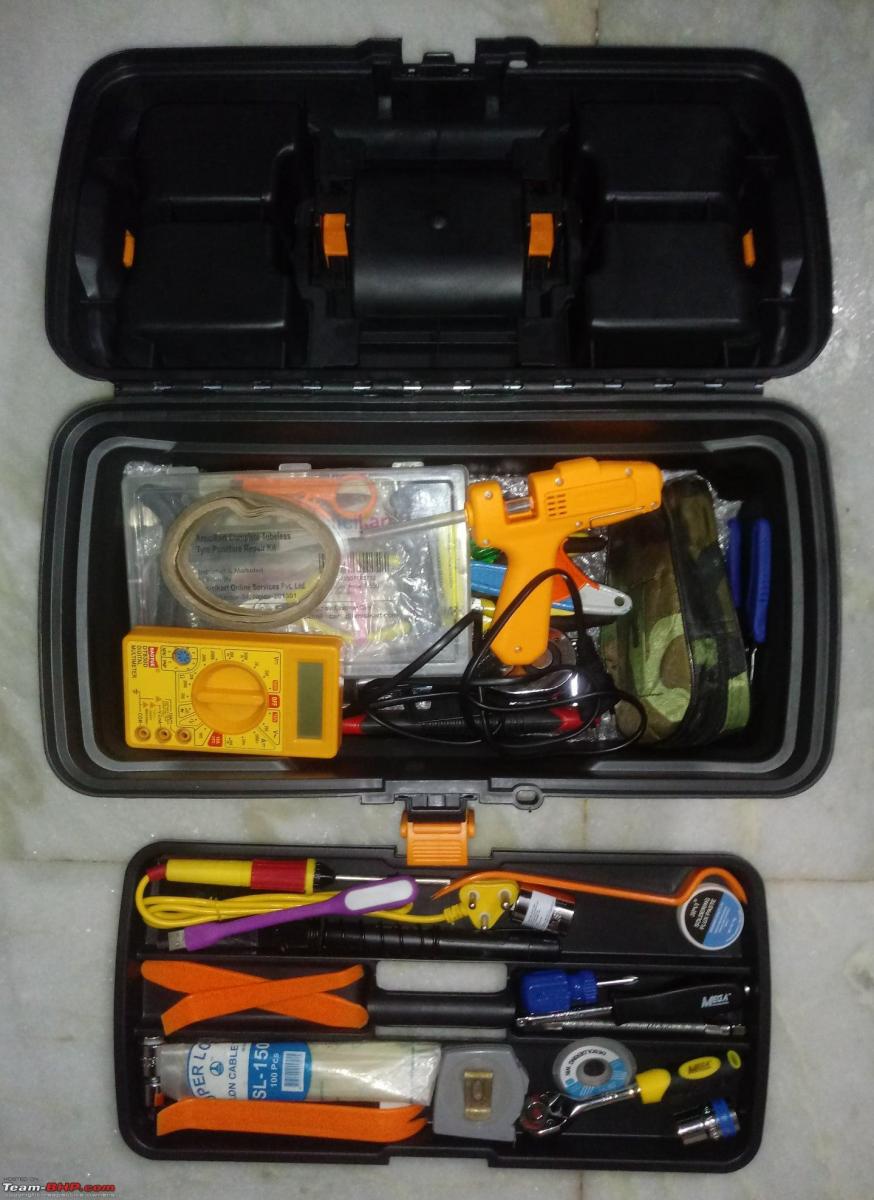
19. Added a portable DIY lithium power station to power most of the electronic stuff when the engine is off and this is the pièce de résistance among all of our DIY projects.

20. The one on the left is the tea/coffee maker and draws approximately 35 watts of power. It takes approximately around 20 minutes to make two cups of tea/coffee in winter. We place it in the front cupholder area of our car while driving after wrapping its base area with a small handkerchief to minimize heat loss through dissipation and prevent the plastic cup holder area from melting. The cover with the silicone seal is very important and helps to prevent spillages while driving. I got this from Amazon India for approximately INR 450.
The one on the right is the 100-watt-rated rice cooker but it draws approximately 109 watts of power. It takes approximately 35-40 minutes to make a meal for two adults. The steel bowl/tray can be placed on the top under the lid and can be used to make lentil soups, water-poached eggs, etc while the rice or rice-based dish like Biryani, Khichdi, Pulao, Kheer, etc cooks below. The lid has two carrying handles and a simple pressure/steam release vent and a metal plate at the bottom. The metal plate prevents any spillage while ensuring proper steam/pressure release. I bought this from eBay India for approximately INR 1100. We usually place this on the "40" portion of the 60:40 split rear seat within the cooker's own cardboard box after tying the box down with the seatbelt. We use the box because that prevents excessive heat dissipation and also prevents the hot cooker from damaging the artificial leather or polyurethane (PU) leather seat covers. While sleeping at the back of the car, we keep it on one of the front seats. This cooker has a "Keep Warm" functionality too for the food.
This is my entire setup for making food and hot drinks in my car. Although both the tea/coffee maker and the rice cooker are rated for 12v, they work best between 13.6v and 14.2v. And we can use them with our portable power station mentioned earlier as well.

21. My son got this Philips GoPure (GP) Compact 110 car air purifier for me since I often suffer from asthmatic attacks. This draws 3.5 watts of power at 12v. This cost us approximately INR 3400 from Philips' brand store in Kolkata a few years ago. It contains a replaceable filter (Model: GSF120X110X1) that lasts anywhere between 6 months to 3 years based on the usage pattern. It is a multi-in-1 filter that claims to filter cigarette smoke, pollens, pet hairs, airborne allergens, dust, particulate matter (PM) 1 and 2.5, airborne virus or bacteria superior to 0.3 microns, etc. It also claims to neutralize and eliminate exhaust fumes, industrial pollution, chemicals emitted by plastic materials and finishes used in car interiors, odour-emitting substances, nitrogen dioxides, sulphur dioxides and total volatile organic compounds (TVOCs). The replacement filter costs approximately INR 1500. We use it in the car only when the engine is off or in winter since at other times the car's own air purification system works perfectly fine in conjunction with the air conditioning system. We strap it to the back of the front passenger seat's headrest as recommended by Philips.

22. Added a 100-watt 12v vacuum cleaner from Eureka Forbes. It has a half-litre dust/dirt storage capacity and the suction is quite powerful. There are quite a few attachments that came with it for reaching into all the nooks and crannies in the cabin of the car. I got it for free when I bought my home vacuum cleaner.

23. Made some privacy curtains for car camping in my Creta. The fabric used to make these curtains is taffeta (double layer) which is the same fabric used to make umbrellas. So it is heat resistant (somewhat), lightweight, lightproof, waterproof and washable. We used some velcro strips to mount these curtains on the grab handles and the sun visors. And we attached some adhesive wall hooks on the high-mounted stop lamp housing to mount the curtains at the back. It cost us a total of INR 800 for the cloth material including the velcro strips along with the wall hooks and I cut and stitched them into shape at home. We also use net-type magnetic sun shades (for INR 700 from Amazon India) on the car windows for keeping away mosquitoes and other bugs.
24. We added a GPS tracker for approximately INR 800 from Aliexpress to an undisclosed location in our car.
25. Window visors were added from Amazon India for approximately INR 600 and you can see them in the image below in the next post.
The items from Aliexpress above and below were obviously procured/received before it was banned in India.
All of these modifications/additions above were done with the sole purpose of not needing to take out anything from the car for enjoying all of the facilities during a car camping trip while keeping weight and cost additions to a minimum. In fact, we do not even need to get out of the car for camping in it. This is a critical aspect if we have to move from the parked location fast. This is especially useful when we are on a tight schedule and do not have to go looking for hotels, resorts, etc. Moreover, there is no time wasted in moving the luggage to and from the brick-and-mortar room or tent, checking in/out, etc and the money saved is the added bonus.
Washroom facilities are availed at nearby toll plazas, food plazas, government offices, banks, religious institutions, etc. I have even asked people for permission to use the washroom facilities in their homes and thankfully, no one has ever refused. We Indians truly believe in "Atithi Devo Bhava" or "Guest is akin to God" and this is irrespective of the people's religion. One may question the hygiene in public washrooms as opposed to private ones in hotels, resorts, etc but just because something looks clean does not mean that it is actually clean. If you have ever checked a hotel/resort room under an ultraviolet blacklight, then you would know that appearances can be very deceiving. Personally, as long as there is enough water accessible in the washroom, we can maintain our hygiene very well with a few basic disinfecting options. As for me, I have been car camping since the 1980s but thankfully, I have never faced hygiene issues due to a washroom simply because of my personal habits with regard to the precautions that I take
Continue reading BHPian Chhanda Das's ownership experience for more insights and information.



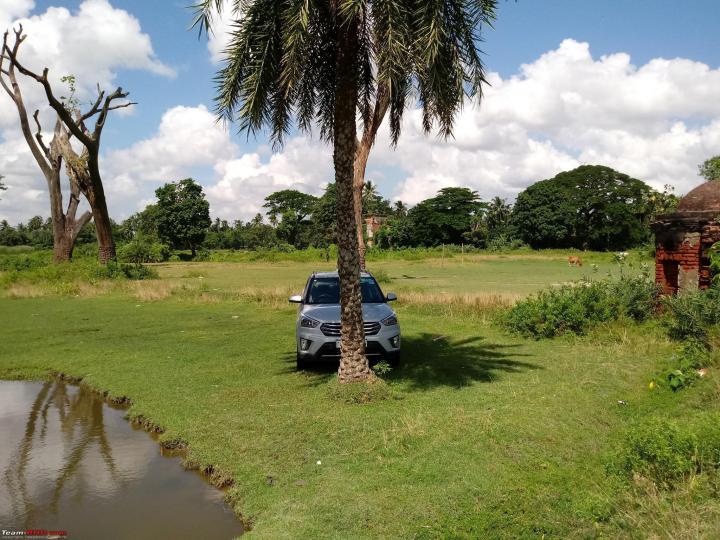


.jpg)
.jpg)







